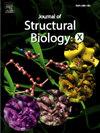鲨鱼单域抗体的产生作为膜蛋白低温电镜结构测定的辅助:以透明质酸合成酶为例
IF 5.1
Q2 BIOCHEMISTRY & MOLECULAR BIOLOGY
引用次数: 0
摘要
在软骨鱼中,免疫球蛋白新抗原受体(IgNAR)天然缺乏轻链。IgNAR的可变区(VNARs)仅负责抗原识别,类似于骆驼的VHHs(重链抗体重链的可变区域)。尽管VNARs引起了越来越多的兴趣,但产生针对膜蛋白的VNARs仍然具有挑战性。此外,VNAR与膜蛋白复合物的结构尚未见报道。本研究以膜蛋白小球藻病毒透明质酸合成酶(CvHAS)为特征,并提供了一种全面的方法来生成其特异性鲨鱼vnas,解决了几个主要问题和重要的优化问题。我们发现鲨鱼生理尿素压力对CvHAS是可耐受的,间接固定化比被动吸附膜蛋白更受欢迎。通过优化以提高单个核细胞(MC)活力和VNAR表达效率,我们成功生成了具有纳米级高亲和力的cvhas特异性VNAR S2F6。然后通过低温电子显微镜(cryo-EM)测定CvHAS-S2F6复合物的结构,报告了第一个膜蛋白和VNAR复合物的结构。结果表明,S2F6与CvHAS的细胞质结构域结合,其表位与报道的CvHAS特异性vhs不同。本研究为膜蛋白vnas的开发及其在结构生物学中的应用提供了有价值的见解。本文章由计算机程序翻译,如有差异,请以英文原文为准。

Generation of shark single-domain antibodies as an aid for Cryo-EM structure determination of membrane proteins: Use hyaluronan synthase as an example
In cartilaginous fish, the immunoglobulin new antigen receptor (IgNAR) is naturally devoid of light chains. The variable regions of IgNAR (VNARs) are solely responsible for antigen recognition, similar to VHHs (variable domain of the heavy chain of heavy-chain antibodies) in camelids. Although VNARs have attracted growing interest, generating VNARs against membrane proteins remains challenging. Furthermore, the structure of a VNAR in complex with a membrane protein has not yet been reported. This study features a membrane protein, Chlorella virus hyaluronan synthase (CvHAS), and provides a comprehensive methodological approach to generate its specific shark VNARs, addressing several major concerns and important optimizations. We showed that shark physiological urea pressure was tolerable for CvHAS, and indirect immobilization was strongly preferred over passive adsorption for membrane proteins. Together with optimizations to improve mononuclear cell (MC) viability and VNAR expression efficiency, we successfully generated S2F6, a CvHAS-specific VNAR with nM-level high affinity. The structure of the CvHAS-S2F6 complex was then determined by cryogenic electron microscopy (cryo-EM), reporting the first membrane protein and VNAR complex structure. It shows that S2F6 binds to the cytoplasmic domain of CvHAS, with a different epitope than the reported CvHAS-specific VHHs. This study provides valuable insights into developing VNARs for membrane proteins and their applications in structural biology.
求助全文
通过发布文献求助,成功后即可免费获取论文全文。
去求助
来源期刊

Journal of Structural Biology: X
Biochemistry, Genetics and Molecular Biology-Structural Biology
CiteScore
6.50
自引率
0.00%
发文量
20
审稿时长
62 days
 求助内容:
求助内容: 应助结果提醒方式:
应助结果提醒方式:


